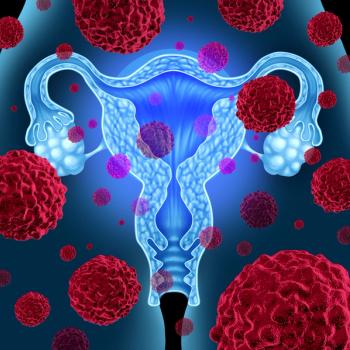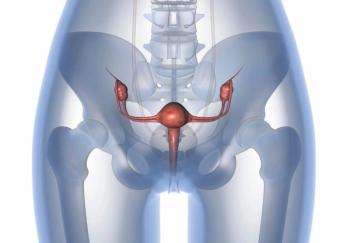
Oncology NEWS International
- Oncology NEWS International Vol 7 No 2
- Volume 7
- Issue 2
Medicare Rule Raises Dilemma in Recurrent Ovarian Cancer
Epithelial ovarian cancer is the leading cause of death from gynecologic malignancies. In 1996, an estimated 26,000 new cases were diagnosed, and approximately 14,000 women died of this disease in the United States alone.[1] Between 75% and 80% of ovarian cancer patients present with advanced disease at diagnosis, and these patients have a 5-year survival rate of 21%.[2,3]
Epithelial ovarian cancer is the leading cause of death from gynecologic malignancies. In 1996, an estimated 26,000 new cases were diagnosed, and approximately 14,000 women died of this disease in the United States alone.[1] Between 75% and 80% of ovarian cancer patients present with advanced disease at diagnosis, and these patients have a 5-year survival rate of 21%.[2,3]
Initial treatment of ovarian cancer includes debulking surgery followed by platinum-based combination therapy.[2,3] These therapiescisplatin (Platinol) or carboplatin (Paraplatin) in combination with cyclophosphamide or paclitaxel (Taxol)are associated with severe and debilitating toxicities, including nausea and vomiting, peripheral neuropathy, ototoxicity, renal damage, and hematologic toxicity.[4]
Despite relatively high clinical response rates, a majority of patients will develop recurrent disease and require additional therapy within 3 years.[5-7] Patients whose disease is refractory to these first-line agents or whose disease relapses within 6 months of therapy are not candidates for additional platinum-based chemotherapy. Also, many relapsed patients are unable to tolerate additional courses of these drugs due to cumulative toxicities.
Current options for single-agent salvage therapy include the intravenously administered agents paclitaxel and topotecan (Hycamtin) and the orally administered agents etoposide and altretamine (Hexalen). Response rates for these agents are similar, ranging from 14% to 26%, while the type and incidence of adverse events with use of these agents are variable.[8-18]
Since second-line therapy for ovarian cancer is almost always palliative, selection of a chemotherapy agent depends on efficacy, safety, and impact on the patients quality of life. Availability of reimbursement to the patient and the financial impact on the health care system are also major considerations.
Under current regulations, Medicare will reimburse outpatient drug costs for oral chemotherapy drugs and supportive agents only when the drug is also available as a marketed intravenous formulation.[19]
This policy is restrictive to the development and utilization of orally administered agents, despite evidence that 89% of cancer patients prefer oral over intravenous chemotherapy (when efficacy is equal).[20] Oral treatments are often not even offered to Medicare patients due to concern over significant out-of-pocket costs.
In an effort to demonstrate the need for reconsideration of reimbursement policies for oral therapies for cancer, we have analyzed the cost of outpatient single-agent salvage therapy for ovarian cancer, accounting for differences in administration protocols and differences in the incidence and treatment of adverse events.
Based on a literature search of published data, we derived, for each agent, tumor response rate, range of median survival times, adverse event incidence and treatment regimens, and chemotherapy comedication protocols (Table 1).
Adverse event treatment regimens and chemotherapy comedication protocols were modified (where necessary) by survey of gynecologic oncology nurse clinicians at three major medical centers to reflect routine clinical practice. A cost analysis model, including the administration protocol and toxicity incidence for each regimen, was then applied.
Costs for physician services were determined based on oncology outpatient Medicare reimbursement protocols, utilizing 1996 Relative Value Units and the Primary Care Conversion Factor.[21,22] The local Geographical Practice Cost Indices were not included in the calculations in order to maintain generalizability of the data. Medication costs were based on those published in the 1996 US Average Wholesale Price Index. Costs for laboratory fees and blood products were obtained from hospital fee lists for Medicare reimbursement.
The cost of treatment per cycle and cost of total treatment based on the median number of cycles received were determined for each agent (Table 2): $2,628 per cycle for paclitaxel ($15,767 for total treatment); $4,659 per cycle for topotecan ($18,635 for total treatment); $746 per cycle for altretamine ($4,477 for total treatment); and $1,672 per cycle for etoposide ($5,016 for total treatment).
The cost breakdown included the cost of drug administration and toxicity monitoring or toxicity treatment. The analysis showed that 26% of the costs for treatment with topotecan and etoposide, and 22% of the costs for paclitaxel, were due to the monitoring and treatment of adverse events, compared with 8% of the costs for altretamine.
This analysis provides timely information to policy makers regarding Medicare reimbursement issues. The policy of denying reimbursement for oral chemotherapy agents that lack an approved intravenous formulation has been called into question not only by drug manufacturers but also by patient advocate groups.
This study determined that oral chemotherapy agents for recurrent ovarian cancer, only one of which is currently eligible for Medicare reimbursement, are less costly than the two available intravenous agents, paclitaxel and topotecan. Savings stem from the lower cost of administering oral drugs and reductions in monitoring and treating toxicities, in addition to lower acquisition price.
Doyle et al[23] found similar results in a Canadian study. For inpatient treatment, chemotherapy agents accounted for only 21% of total costs, with an additional 62% of costs from inpatient admissions and 17% from other supportive care, for a total average treatment cost of $40,810. Treatment regimens included mainly carboplatin, paclitaxel, ifosfamide (Ifex), and altretamine.
For outpatient administration in the Doyle study, the cost of chemotherapy agents represented 50% to 84% of the total costs, for a total average treatment cost ranging from $373 to $1,763. Treatment regimens included cisplatin, carboplatin, ifosfamide, paclitaxel, altre-tamine, and melphalan (Alkeran).
Total costs in this study were markedly different from those in our study, reflecting the difference in agents evaluated and in the US and Canadian health care systems.
The impact of Medicare reimbursement policies has also been noted in other areas of cancer care.
Oral antiemetics are reimbursed only under very specific and limited circumstances. Only one dose is covered for use prior to chemotherapy with Medicare-approved oral chemotherapy agents, when necessary to ensure oral absorption. Oral antiemetics given with intravenous chemotherapy agents in the outpatient setting are not covered at all by Medicare.[24]
Emphasis on Economics
Health care costs are escalating rapidly, while resources remain limited. To allow for optimal planning for use of these resources, physicians must place increasing emphasis on economic factors when they evaluate therapies and make clinical treatment decisions. Studies of costs and cost effectiveness facilitate this process.
Because long-term survival of ovarian cancer patients following salvage therapy is extremely poor, it is important to consider factors affecting quality of life when making treatment decisions, including the convenience of therapy administration, the incidence of discomfort and debilitating adverse events, and the financial implications of out-of-pocket costs.
Medicare policies that do not reimburse for oral outpatient medications unless an intravenous formulation is also available are likely to impact on therapeutic recommendations for cancer patients.
References:
1. Cancer Statistics 46(1):10-11, 1996.
2. Thigpen J, Blessing JA, Vance RB, et al: Chemotherapy in ovarian carcinoma: Present role and future prospects. Semin Oncol 16:58-65, 1989.
3. Thigpen J, Vance RB, Khansur T: Second-line chemotherapy for recurrent carcinoma of the ovary. Cancer 71:1559-1564, 1993.
4. McKeage MJ: Comparative adverse effect profiles of platinum drugs. Drug Safety 13(4):228-244, 1995.
5. Ozols RF, Rubin SC, Dembo AJ, et al: Epithelial Ovarian Cancer, pp 731-732. Philadelphia, JB Lippincott, 1992.
6. McGuire WP, Hoskins WJ, Brady MF, et al: Cyclophosphamide and cisplatin compared with paclitaxel and cisplatin in patients with stage III and stage IV ovarian cancer. N Engl J Med 334:1-6, 1996.
7. Markman M, Rothman R, Hakes T, et al: Second-line platinum therapy in patients with ovarian cancer previously treated with cisplatin. J Clin Oncol 9:389-393, 1991.
8. Eisenhauer EA, ten Bokkel Huinink WW, Swenertokn KD, et al: European-Canadian randomized trial of paclitaxel in relapsed ovarian cancer: High-dose versus low-dose and long versus short infusion. J Clin Oncol 12:2654-2666, 1994.
9. Aravantinos G, Skarlos DV, Kosmidis P, et al: A phase II study of paclitaxel in platinum pretreated ovarian cancer: A Hellenic Cooperative Oncology Group Study. Eur J Cancer 33(1):160-163, 1997.
10. Bruzzone M, Catsafados E, Miflietta L, et al: Salvage chemotherapy with paclitaxel in platinum-resistant advanced ovarian cancer patients. Oncology 53:349-353, 1996.
11. Gore ME, Levy V, Rustin G, et al: Paclitaxel in relapsed and refractory ovarian cancer: The UK and Eire experience. Br J Cancer 72:1016-1019, 1995.
12. Ten Bokkel Huinink W, Gore M, Carmichael J, et al: Topotecan versus paclitaxel for the treatment of recurrent epithelial ovarian cancer. J Clin Oncol 15:2183-2193, 1997.
13. Creemers GJ, Bolis G, Gore M, et al: Topotecan, an active drug in the second-line treatment of epithelial ovarian cancer: Results of a large European phase II study. J Clin Oncol 14:3056-3061, 1996.
14. Kudelka AP, Tresukosol D, Edwards CL, et al: A phase II study of intravenous topotecan as a 5-day infusion for refractory epithelial ovarian carcinoma. J Clin Oncol 14:1552-1557, 1996.
15. Vergote I, Himmelmann A, Frankendal B, et al: Hexamethylmelamine as second-line therapy in platinum-resistant ovarian cancer. Gynecol Oncol 47:282-286, 1992.
16. Manetta A, MacNeill C, Lyter JA, et al: Hexamethylmelamine as a single second line agent in ovarian cancer. Gynecol Oncol 36:93-96, 1990.
17. Hoskins PJ, Swenerton KD: Oral etoposide is active against platinum-resistant epithelial ovarian cancer. J Clin Oncol 12:60-63, 1994.
18. Rose PG, Blessing JA, Mayer AR, et al: Prolonged oral etoposide as second line therapy for platinum resistant and platinum sensitive ovarian carcinoma: A Gynecologic Oncology Group study (abstract). Proc Am Soc Clin Oncol 15:762, 1996.
19. Medicare Carriers Manual: Drugs and Supplies, Section 2049.5 Coverage and limitations, 2-18.22, 05-96.
20. Liu G, Franssen E, Fitch MI, et al: Patient preferences for oral versus intravenous palliative chemotherapy. J Clin Oncol 15:110-115, 1997.
21. Practical Tips for the Practicing Oncologist. Alexandria, Va, American Society of Clinical Oncology, 1997.
22. Federal Register. Vol. 61, No. 227; Fri Nov 22, 1996.
23. Doyle C, Stockler M, Pintilie M, et al: Resource implications of palliative chemotherapy for ovarian cancer. J Clin Oncol 15:1000-1007, 1997.
24. Ignoffo RJ: Medicare reimbursement for oral antiemetics in management of chemotherapy-induced emesis. Am J Health-Syst Pharm 54:830-831, 1997.
Articles in this issue
almost 28 years ago
Tobacco Companies Reach Settlement With Texas for $15.3 Billionalmost 28 years ago
Archives to Collect Info on Radiation Exposure Worldwidealmost 28 years ago
Few BRCA-1 Carriers Take Recommended Precautionsalmost 28 years ago
Lifelong Weight Control a Key to Breast Ca Preventionalmost 28 years ago
Eight-Year Prostate Brachytherapy Update Shows Good Resultsalmost 28 years ago
Patient Brochure on Breast Cancer Tumor Markersalmost 28 years ago
Gay Men’s Health Crisis Calls for HIV Reporting in New Yorkalmost 28 years ago
Single-Agent Taxanes in Advanced Breast Cancer: A Commentaryalmost 28 years ago
ODAC Declines to Vote on DepoCyt FDA Recommendationalmost 28 years ago
Photofrin Approved for Early-Stage Lung CancerNewsletter
Stay up to date on recent advances in the multidisciplinary approach to cancer.

















































































